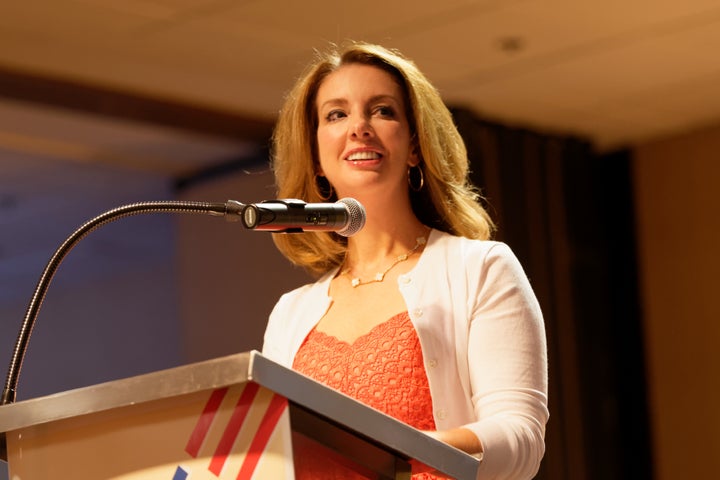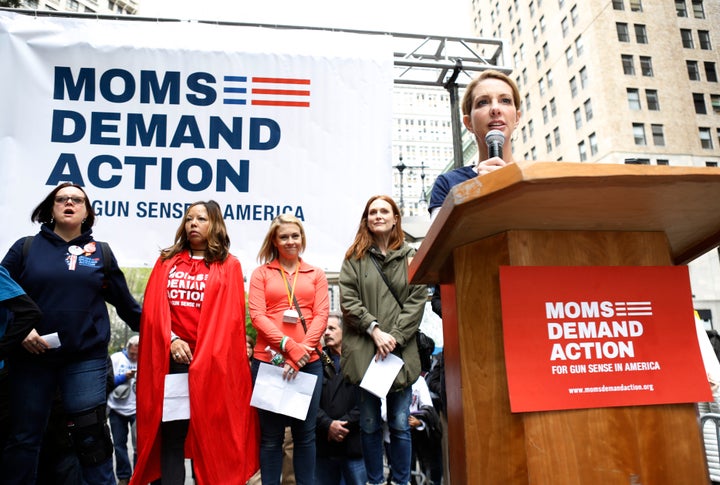
On December 14, 2012, Shannon Watts was folding laundry in front of the television when she heard the news: Twenty little children had been shot to death inside their elementary school in Sandy Hook, Connecticut.
Watts, a stay-at-home mother of five, began to cry. But as she continued watching coverage of the tragedy, her emotions flipped from desolate to furious. The prevailing attitude, aired by resigned pundits, was that shootings were inevitable. The next day, she decided to act. Envisioning a group of moms working against gun violence, in the vein of Moms Against Drunk Driving, she created a Facebook page calling for action.
At the time, she had 75 friends on the social media platform. Now seven years later, her organization, Moms Demand Action for Gun Sense In America, has nearly 6 million supporters and chapters in all 50 states. Watts has documented this meteoric rise in a new book, “Fight Like a Mother,” released this month.
HuffPost recently spoke with Watts about becoming an activist, battling the National Rifle Association, and how President Trump’s election inspired her to start using her real voice.
Can you reflect on the moment you decided to launch Moms Demand Action?
Right after Sandy Hook, I was seeing pundits on my television telling me that the answer was more guns. I didn’t know anything about activism or gun laws but I knew that was not right. We were already a nation full of guns with very few gun laws, and that was not working. I felt like I had to do something. I thought that something would be to look online for an organization I could join. But all I came across were think tanks, mostly in Washington, D.C., run by men, or one-off state organizations mostly run by men. I wanted to be part of a badass army of women, like Mothers Against Drunk Driving. And that’s when I started the Facebook page, just thinking, OK, I’ll have a conversation with other people online. I can remember my husband saying, do you really want to put yourself out there? There was some hesitancy. I certainly never imagined it would become what it has, but at the same time, I felt like I was jumping into the fray.
One of the things I was struck by is how many other women stepped up to help you get the organization off the ground.
Within hours, all these type-A women started googling me and finding my phone number and my email address and saying, I want to do this where I live. None of us knew what this was, we just knew we wanted to act. I had calls from all over the nation, from Houston to Chicago to North Dakota. Everyone was willing to offer me their expertise. Michelle Sandberg, pediatrician and sister to Sheryl Sandberg, called me and said, “Come to our house and let’s have a conversation with women in the area who want to get involved.” I remember going out there and Sheryl Sandberg was there. I had web developers say, I’m going to create a website for you. Sarah Brady messaged me, and said, “You need to start a Twitter handle right now.” Trademark lawyers reached out. Experts in gun research and gun policy made themselves available. I didn’t know what I was doing. I wasn’t an activist, I wasn’t politically active. I knew nothing about gun laws. But I knew our nation was broken. And so many other women did too. And we decided not to wait for permission. We were confident that we could help each other and trust one another and build the plane as we flew it. And we did. We took advantage of the grief and anger in the country and a desire for change.
Over the time I’ve been following you, your online presence has really changed. Can you talk about that?
I had a Twitter handle that was completely inactive when I started Moms Demand Action. And I spent the first few years using it to share talking points from our organization. After the 2016 election, I decided that I was no longer going to be passive, and that I was going to use my real voice on Twitter. I was going to say what I thought.
Middle-aged women are pretty invisible in this society. I’m a white woman, but I have to imagine it’s worse for women of color. There are gatekeepers that decide whether you get to tell your story or not. And I realized that social media was a way to bypass the gatekeepers, and to tell our story. You know, women are responsible for so much unpaid labor in this country. I’m a full-time volunteer. And grassroots activism is really unglamorous. I wanted to showcase that. And I wanted to talk about the ways that our mostly male lawmakers were endangering us and our families and our communities. Right before Donald Trump’s election, I think I had something like 23,000 followers. Now I have 336,000 followers.

A few months after you created the organization, an effort to expand background checks, pushed by President Barack Obama and Democratic leadership, was defeated. What was that like?
I was sitting in the Senate gallery the day that [Manchin Toomey] didn’t pass by just a handful of votes, including from several Democrats. By the way, not a single one of the Democrats who voted against that bill is still in office. Heidi Heitkamp was the last to lose her job. She said afterwards that she voted against it, even though she’s a mom and a woman from North Dakota and a Democrat, because she heard more from the other side. I can remember thinking, that’s never gonna happen again. We’re going to make sure that no lawmaker can say that. They can say they voted against it because they wanted to. But they can’t say they did it because they didn’t hear enough from our side.
I wasn’t sure what would happen after the vote. I wondered if people would give up. If the organization would sort of dissipate because we lost and people would think, OK, well, the country isn’t ready for this. But what happened was amazing. Our volunteers intuitively pivoted to doing this work in their own state houses and boardrooms. Congress wasn’t going to act, but there were so many governors who would. And so we started putting pressure on state legislatures to do the right thing. We also quickly realized that there was a whole lot of defense involved in this activism.
Can you expound on that a bit?
Every year the NRA is insidious in state houses in passing bills that loosen gun laws, legislation like permitless carry, guns on college campuses, arming teachers, expanding stand your ground, etc. All these things that put their agenda forward, which is basically guns for anyone, anywhere, anytime, no questions asked. Just by showing up, we were able to defeat a lot of that legislation. Last year, we beat back over a thousand of those bills.
How has the NRA responded to you personally?
They started attacking me early on when they saw that we were gaining traction, especially when we partnered with Mayor Bloomberg’s Mayors Against Illegal Guns, and created Everytown for Gun Safety. The very first article they wrote about me was headlined “NOT WATT SHE SEEMS.” The drawing they used was a picture of me in a 1950s green dress, surrounded by a frying pan and an iron and a duster, all these anachronistic symbols of motherhood. They basically said I wasn’t a real stay-at-home mom. They called me AstroTurf. It was important to them to make me seem illegitimate, to try to erode my credibility.
Recently, around Mother’s day, the NRA started attacking me directly. On Instagram, they tagged me in posts, intending to send their trolls after me who immediately started threatening to kill me. They did the same thing on Twitter. I think it’s a distraction. They’re trying to get their following to be more interested in going after me, instead of reading about how they’re misspending and mismanaging their members’ money.
Can you talk about the safety concerns associated with this work? In the book, you mention a security guard you travel with who is unarmed.
His job is basically to find the nearest hospital to take me to if something happens. I travel using an alias. I just have to be very careful about what I share and who I share with. The amount of death threats and threats of sexual violence I get to me and to my daughters is pretty astounding. I have seen an underbelly of America that I did not know existed. But at the end of the day, I refused to be intimidated, and silenced and even scared. I decided a long time ago that doing this work and changing our nation’s culture of gun violence was more important than anything else.
What do you hope readers take from the book?
The book is part memoir. It talks a lot about how being an activist changed my life, my family, my friendships. It’s part manual. I have had so many calls, mostly from women, asking how I did this and how they can do it where they live. And it’s part manifesto. I think it’s important that women and moms take the skills they learned as activists, and move from shaping policy to making it. We had 40 volunteers run for office in November, and 17 of them won, including Georgia Rep. Lucy McBath.
What do you consider your greatest victories?
One of the things I’m most proud of is that we have helped pass laws in 28 states to keep guns out of the hands of domestic abusers. A lot of people don’t realize that federal law is narrow in the definition of who a domestic abuser is. And it doesn’t give law enforcement permission to remove the guns domestic abusers already have. So we go into states and broaden the definition and put teeth in the law that allows law enforcement to remove their guns. Those are hard-fought battles. I’ve also been proud of making this a voting issue, particularly among women. For so long we’ve known the majority of Americans support stronger gun laws, but it hasn’t been a voting priority. A poll came out from CNN that showed this was the No. 3 issue for Democrats going into 2020. That is a sea change. You can see it reflected in the Democratic candidates, they’re all competing to see who can be the best on this issue. Gun violence prevention was a third rail of American politics just a few years ago!
Speaking of 2020 candidates, is there anyone you are particularly excited by?
We are handing out a questionnaire to the candidates about their positions on gun safety. When we get that data back, we’ll have a much better understanding who supports what and who is being innovative. It’s one thing to support it, but are you making it a priority in your policy platform?
